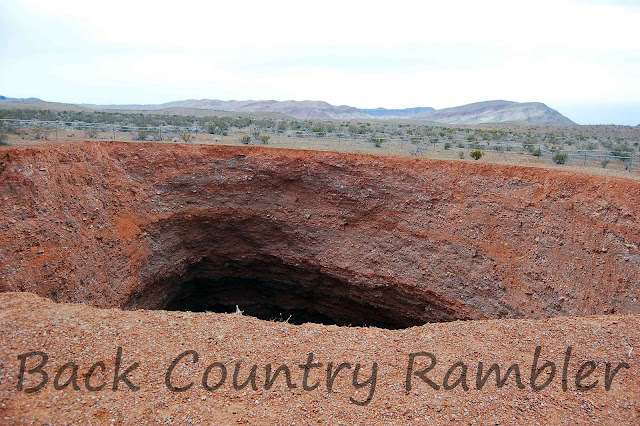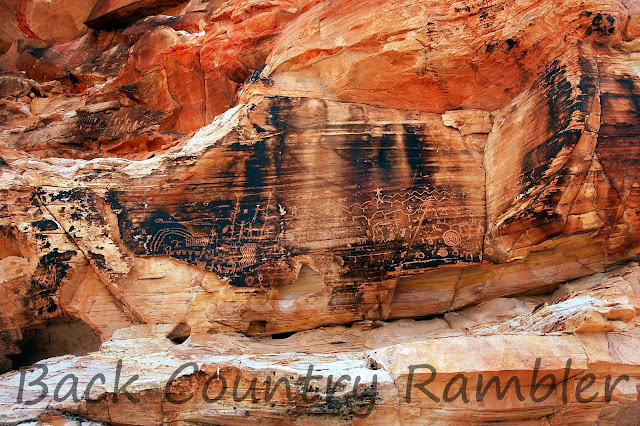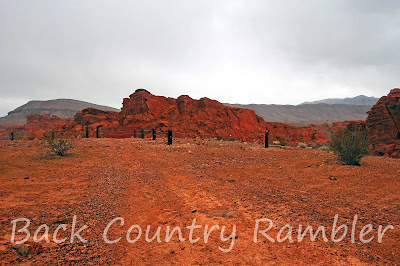Cedar Basin is tucked within one of the many mountain ranges of the Gold Butte country. Within this basin there are stories of hidden Spanish treasure, mining, cattle ranching, and drug smuggling to name a few. Like many of the places that I write about in Back Country Rambler, Cedar Basin is filled with a natural desert beauty and topped with a rich chronicle of human and natural history.
Cedar Basin is encircled by many uncommon rock formations. The largest cluster of rocks are found on the north and east side of the basin. When exploring these odd rock formations in Cedar Basin it makes me think of what it would be like to explore on the moon. The Tramp and Forks Fires back in 2005 burned off most the cactus, cedar trees and brush so it seems like more than ever like you could be walking
on the lunar landscape.
On the eastern side of Cedar Basin is Grapevine Springs. Grapevine Springs is actually more of a catch pond for the early desert Spring rains than it is a spring. This catch pond was used to support the cattle herds that were run through this country in years past. My grandfather was one of the cowboys who ran cattle through the Gold Butte grazing allotment in the 1970’s and early 1980’s. Gramps says about the Gold Butte grazing allotment that “the cactus done well and they made a little money selling rough stock for the rodeos in Salt Lake.” Cedar Basin was normally used for early spring range when the pond was full and you needed a good coral to work the spring calves.

Mining has also played a part in the history of Cedar Basin. On the maps the Radio Crystal mine is marked as the largest mine in the basin. However today the mine is know as the Treasure Hawk mine run by the Cutthroat mining company. From the little that I know about the place and from talking to people around it sounds like the Radio Crystal Mine or the Treasure Hawk mine was after silver, lead and zinc. The most recent owner of the claim was John Lear. I ran into him and some of his friends out there when I was visiting Grapevine Springs. They seemed like good enough folks. Lear lost the mining claim a few years ago and is now charged with cleaning the place up. There are still some buildings there and some old equipment and shafts here and there. If you plan on visiting this old mining claim use your head and watch your step and as the Bureau of Mines says, “Stay out and stay alive.” For more information about John Lear and his take on the country you can visit his site by clicking here.



One of the other many attractions of Cedar Basin is the stock corral and the landing strip located in the center of the basin. This corral was used in years past for working the spring calves. The airport however has an interesting story of its own. In the 1960’s and 70’s the Radio Crystal mine was run by a little more crooked outfit. Now the exact details about this whole operation are a little shady so this is the story as I have pieced together by people that I know who were in the Gold Butte Country at the time. It is rumored that the people who where running the mine in those days were possibly growing some agricultural products that were not exactly legal, then or now. These people were also connected with an outfit from Mexico who smuggled more “agricultural products” in by plane to the Cedar Basin landing strip. Some of the locals out in the country at the time knew what was going on but also knew to stay away. My father in law was an occasional hand on some the spring and fall gatherings and remembers being told to stay out of the basin when certain operations were going down. Eventually the authorities stepped in and the operation was stopped.
(below is the remnants of the old Cedar Basin Landing Strip)
The details about the buried treasure, as treasure stories always seem to be, are a little sketchy. However I have heard about it from two difference sources so I will share what I have heard. It is a well known fact that the Spanish explored this country in earlier times looking for gold. There are remnants of their explorations and mining efforts scattered all through out this state and much of the west. In the hills of Cedar Basin there is evidence of their explorations and mining ventures. It is rumored that the Spanish left some gold in these hills for a time when they could come back and get it another day. It is supposed to be marked by a petroglyph, however I have yet been able to find the marking or the treasure.

Cedar Basin can be found near what is now called the Gold Butte Back Country Byway. Once you get to Gold Butte Headquarters you continue down the road roughly two miles and then turn left and head up the wash to enter Cedar Basin. To view a map of the area check out my Trip Map page and click the button under the map labeled Cedar Basin. As always, use your head when out in the back country and don’t put yourself in a situation that can leave you venerable to Mother Nature’s untamed power. This is a rough road in rough country. You will most definitely need a high clearance vehicle and four-wheel drive is advised. However the sites are worth it and the country is grand. Enjoy it while you can.
Vicinity Destinations























































